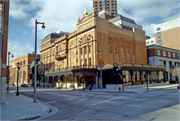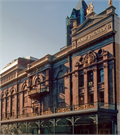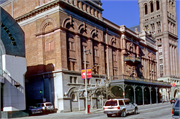| Additional Information: | A 'site file' exists for this property. It contains additional information such as correspondence, newspaper clippings, or historical information. It is a public record and may be viewed in person at the Wisconsin Historical Society, State Historic Preservation Office.
Learn more at this link http://www.wisconsinhistory.org/hp/register/viewSummary.asp?refnum=72000063
LOCALLY DESIGNATED 12/7/82. HABS WI-269. NHL 12/4/91. This building is also a contributing resource in the Plankinton-Wells-Water Street Historic District (listed: 6/13/86).
German-ethnic Milwaukeeans of the late nineteenth century liked to think of their city as the “Deutsch-Athens,” a vibrant and sophisticated capital of German-American culture. Few people did more to make the reputation a reality than Captain Frederick Pabst. One of the city’s famous beer barons, Pabst enthusiastically promoted the German arts and architecture. In 1890 he bought the old Nunnemacher opera house, across from City Hall, and made it a leading performance house for German-language drama and music. When it burned in 1895, Pabst, had Pabst Brewing Company architect Otto Strack design its replacement. Grandly proportioned, luxuriously ornamented, boasting top-notch stage facilities, excellent acoustics, and the latest in fireproof technology, the new Pabst Theater opened in November that same year. Dedication ceremonies included a march composed for the occasion, and the American debut of a German-language comedy, imported from the Berlin theater circuit.
Extensive restoration work in 1976 included creation of its east elevation, followed by a lobby addition in 1989.
The Pabst is one of the few survivors from the golden age of German-language theater in America, and it is Milwaukee's sole surviving nineteenth-century opera house.
"The Pabst Theater is one of the few remaining structures in the country associated with the golden age of German language theater in America, and it is Milwaukee's sole surviving 19th century opera house. It was built in 1895 by brewing magnate Fred Pabst to replace an earlier theater on the site that had burned. It was intended to rival in splendor any theater of its size in Germany. Incredibly, it was built in less than a year to comply with Captain Pabst's orders.
Its architect, Otto Strack, was born in Roebel, Germany and had been trained in the building trades as well as architecture in Berlin and Vienna. He came to the United States in 1881 and conducted a successful architectural practice in Chicago before relocating to Milwaukee in 1888. His European training made him popular with Milwaukee's German-American businessmen, and he did considerable commercial work for the Pabst Brewing Company as well as designing houses for the Pabst family and other clients. His most impressive surviving house is the Kalvelage House, featured in another booklet in this series. Although described as being "Renaissance" in style when first built, the Pabst Theater reflects Strack's interpretation of the German Baroque and features a mansard roof above the stage area. The orange brick, terra cotta ornament and decorative iron work were design features preferred by German clients. Of the many eyecatching details, of particular note is the terra cotta cartouche or plaque at the east end of the facade emblazoned with the letter "P," the Pabst monogram. Also interesting is the figural bust set in a shell niche at the center of the facade above the delicate iron balcony. No one knows if she depicts any particular person, and so she is simply known locally as the "Lady in the Shell." The gilded urns and a lyre that crown the parapet at the east end served as symbols of the building's theatrical use.
The Pabst Theater showcased the talents of Milwaukee's German language stock theater company. The lead roles in the productions were frequently performed by famous German actors on tour in the U.S. After World War I, German theater rapidly declined in popularity. The Pabst later presented English language drama and motion pictures. The building was acquired by the City of Milwaukee in 1961 and restored to its original magnificence by Conrad Schmitt Studios and Mark F. Pfaller and Associates in 1975-1976. The Pabst is now linked by a galleria to a new office building and hotel complex called the Milwaukee Center, built 1986-1988. A new, more specious lobby for the Pabst, opening off the galleria, was added in 1989. Tours of beautiful, European-style opera house interior are offered to the public on a regular basis. The Pabst Theater is a Locally Designated Historic Building and is located within the Plankinton/Wells/Water Street National Register Historic District." MILWAUKEE ETHNIC COMMERCIAL AND PUBLIC BUILDINGS TOUR, CITY OF MILWAUKEE DEPARTMENT OF CITY DEVELOPMENT, 9/1994. |
|---|
| Bibliographic References: | THE HISTORIC NAME CAME FROM SOURCE A ON THE ISF.
THE DATE OF CONSTRUCTION AND THE NAME OF THE ARCHITECT ARE FROM THE NR NOMINATION.
MILWAUKEE ETHNIC COMMERCIAL AND PUBLIC BUILDINGS TOUR, CITY OF MILWAUKEE DEPARTMENT OF CITY DEVELOPMENT, 9/1994.
BUILT IN MILWAUKEE, LANDSCAPE RESEARCH, P. 86.
MILWAUKEE JOURNAL 1/8/1995.
MILWAUKEE HISTORIC BUILDINGS TOUR: JUNEAUTOWN, CITY OF MILWAUKEE DEPARTMENT OF CITY DEVELOPMENT, 1994.
MILWAUKEE JOURNAL SENTINEL 5/18/1995.
MILWAUKEE JOURNAL SENTINEL 8/15/1996.
National Register Nomination Form.
Buildings of Wisconsin manuscript.
Pagel, Mary Ellen & Virginia Palmer for the University of Wisconsin Extension Division, Guides to Historic Milwaukee: Juneautown Walking Tour, 1965. |
|---|





